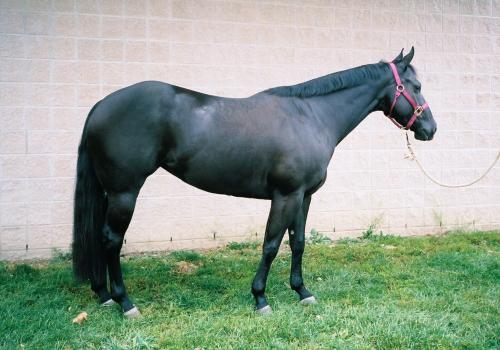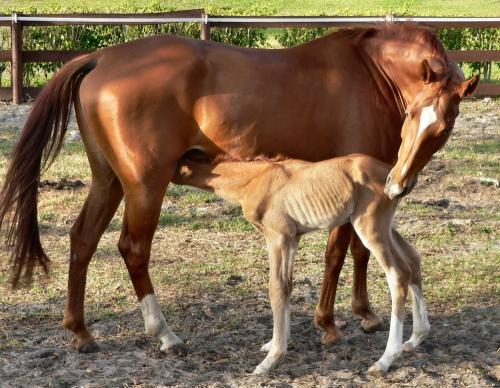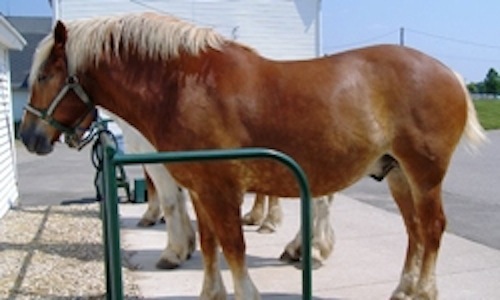Determining the optimum body condition score for your horse
A horse’s age, activity level and reproductive status should be considered when determining an optimum body condition score.
The optimum body condition score should be determined on an individual basis, considering the horse’s workload, age and production status as primary factors. A young growing horse should be developing healthy skeletal and muscle tissue without excessive fat tissue. Both clinical and field observations suggest that excess weight can cause a growing horse to have bone abnormalities, especially if there is a genetic predisposition to developmental orthopedic disease. A goal of a moderate body condition score of 5 would guard a healthy young horse from unnecessary fat that would burden developing bone tissue.

This mare has a moderate body condition score of 5. She is in good shape for work or breeding.
A performance horse needs body fat stores to provide energy for exercise. Too much body fat can decrease performance and hinder a horse’s ability to dissipate heat during hot weather. However, a thin horse does not have enough energy stored to maintain a high performance level. An optimum BCS for a performance horse ranges from 5 through 7, depending on its work requirements. For example, a draft horse used for pulling would be kept closer to a BCS of 7 while a racehorse would be kept closer to a BCS of 5.
A broodmare’s energy demands double once a foal is delivered and begins to nurse. A mare has her highest energy needs during peak milking period. A thin mare will have a higher incidence of reproductive failure, that is, failure to conceive or early abortion, than a mare kept in a moderate to fleshy condition (BCS 5 – 7). Thus a breeding manager should keep a broodmare no lower than a moderate BCS (5) during breeding and gestation. Preferably a broodmare should foal in a BCS of 6 or 7 to ensure that she is at least a BCS 5 during peak lactation. Prior to gestation, a mare should have adequate body fat stores to approach the breeding shed at a moderate body condition (BCS 5).

This mare should be kept in moderate body condition (BCS 5) to ensure she can provide nutrition for her foal and will be ready for rebreeding.
A geriatric horse should be maintained at a condition score of 5.5 through 6.5. An older horse tends to have a more difficult time gaining weight. A horse with Cushing’s Disease may also be harder to score as a result of a long hair coat. In addition, horses with a metabolic disorder may have visible ribs, but may store fat extensively in other areas like the crest of the neck.
The most important aspect of body condition scoring is to accurately determine if your horse is thin, moderate or fat. If your horse is in the moderate range you are doing a good job of balancing your horse’s energy needs with his energy intake. If your horse is thin, then you need to work with your veterinarian or a nutritionist to get your horse into the moderate range. A fat horse is more prone to nutritionally related diseases. You should also work with a veterinarian and/or nutritionist to get your horse to a more moderate and safer body condition score.

This fat horse depicts a body condition score of eight. Note the cresty neck and fat deposits behind the shoulders and along the tail head.
Learn more about body condition scoring by testing your skills at Body Condition Scoring by trying this activity from eXtension.org/horses. Or watch Equine Energetics a My Horse University and eXtension.org/horses webinar that provides an overview of calorie requirements and energy utilization for horses.
Related article



 Print
Print Email
Email

